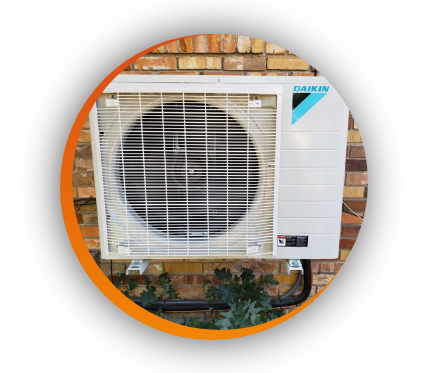It seems everyone is looking for ways to save money on their electric bill when it comes to heating and cooling needs. This is especially true here in Bountiful, UT, where we get the extremes in temperature. People call us at Blue Best Plumbing, Heating, Air, Generators to ask about mini splits systems and whether they are more efficient than the central air systems. In this blog, we will explore mini-split systems and their efficiency.
What Is a Mini Split?
A mini split has an outdoor unit and one or more indoor units. The indoor units have blowers that place the cool air into different rooms of your home. Mini-splits are also known as ductless air conditioners because they do not use ductwork like central air conditioning systems. Instead, they have a refrigerant line that delivers the refrigerant to each indoor unit. The indoor unit has a blower, an air filter, and coils. Warm air is blown over coils that are filled with refrigerant, creating cool air.
There are mini splits that work as both air conditioners and heat pumps. Most of these heat pump mini splits are not suitable for the Wasatch Front, but there are models that can deliver energy-efficient heating in temperatures that dip down to -13 degrees Fahrenheit.
Efficiency and Pros of Choosing a Mini Split
Mini-splits are amazingly efficient. They have technology that sets them apart from traditional air conditioning systems. For one, they have an inverter that converts your home’s AC electricity to DC, direct current. This allows the mini split to run much more efficiently on energy.
Also, mini splits have variable-speed compressors. Since they can run a variety of speeds, they only use as much energy as needed to keep the room at the temperature you set. Central air conditioning units tend to either have only one speed or two. That means that central air conditioning unit compressors are either cycling on or off or cycling between two speeds and off. Variable-speed compressors keep your rooms at an optimal temperature almost all the time. They don’t need a lot of cycling on, and off as central air conditioning systems do. Therefore, mini splits have phenomenal SEER ratings in the 30s. Their heating ratings are equally impressive.
The other big deal about mini splits is that you can select different zones to cool. You have different indoor units in different rooms. This allows for more efficiency when you don’t need to cool every room of your home. You only must cool those rooms you are using. Some people just buy a mini split to cool a garage or a finished basement while a central air conditioning system cools much of their house.
Cons of Mini Splits
Mini-splits lack the powerful air filtration that central air conditioning systems have. Central air conditioning uses much larger, thicker, and more effective filters. Although there are carbon inserts and air purifiers you can install in the mini split, they will not do as good of a job of keeping out allergens and odors in your home. The reason for this is that the mini split is simply using the same air that is already present in your home.
Mini-splits sometimes have issues with condensation and removing it to the outdoors. If you can run a line downhill, there is no problem. If you cannot, you will need a condensate pump in your mini split. This is an additional cost and will need regular maintenance. The condensate pump is also noisy.
Another strike against mini splits is what can happen if they are not maintained by cleaning the filters every few weeks. If you neglect this responsibility, the mini split will not have the same efficiency as its SEER rating. Eventually, the unit will prematurely fail because the unit is straining unnecessarily. All that energy efficiency is then wasted.
Since energy efficiency is about saving money, this is another problem with mini splits. The initial cost is often 30% more than a central air conditioning system when the latter already has ductwork. The reason for this is that most homes will require multiple mini-split indoor units or “heads.” A mini-split system can have many mechanical boxes to keep your entire house cool.
At Blue Best Plumbing, Heating, Air, Generators, we can provide you with estimates of both types of systems. Therefore, you can see both the initial cost and energy savings of each type of air conditioning system for your home.
Pros and Cons of Central Air
Central air has many of the opposite pros of mini splits. These include:
- Often lower initial cost
- 14 to 20 SEER still very efficient
- Better whole-house coverage
- Better air filtration
- Better integration with dehumidifiers, humidifiers, and air purifiers
If you have an older air conditioning unit that is 15 or more years old, you will save quite a bit of money by getting a newer central air conditioning unit. The older air conditioning units often only have a SEER of 8 or 9. A SEER of 15 will save you a lot of money on your unit’s electricity costs. Also, you will save money if your home already has ducts installed.
If your home is over 2,000 square feet or has an open floor plan, central air conditioning will save you money because the sheer number of indoor heads needed will no longer be energy efficient. Also, mini splits cannot cool large rooms without using multiple indoor heads.
Central air conditioning units also have some cons. These include:
- Higher utility bills for smaller homes with zones
- Cost of duct maintenance
- Less control of individual room temperature
- Can’t shut off zones, only vents
If you shut off a vent, the central air conditioning unit is still blowing the same amount of air. Also, most people will opt for the budget-friendly single-stage condenser that will just cycle on or off.
The answer to the question posed in the title is that sometimes mini splits offer more energy efficiency. Their SEER ratings are higher than central air conditioning units. That does not mean that a mini split will be the most energy-efficient air conditioning unit for your home. If your home has an open floor plan, a mini-split will likely be less energy efficient. These units are designed to cool individual rooms as opposed to larger spaces.
If your home has many rooms, energy efficiency may only be achieved if you can shut off cooling to some of the rooms during the day that is unused. Otherwise, it may indeed be more efficient to install a central air conditioning unit or replace an older unit that is nearing the end of its service life. We can help you by coming out and giving you a personalized estimate of each of these options for your home.
Contact Us for All of Your HVAC Needs
At Blue Best Plumbing, Heating, Air, Generators in Bountiful, UT, we have been serving the Wasatch Front for the past 20 years. We are a woman-owned company that provides air conditioning and heating installations, repairs, and maintenance services in our local community. We pride ourselves on our honesty and integrity. In addition, we are a Lennox Premier Dealer and a Daikin Comfort Pro Partner, so you will have your choice of top-rated units when you need an installation. If you have an air conditioning or heating repair need, we provide 24/7 service. We also provide indoor air quality services and can install dehumidification and air filtration systems in your home. We finance installations on approved credit.
Call us at Blue Best Plumbing, Heating, Air, Generators in Bountiful today if you have more questions about mini split versus central air conditioning units.








